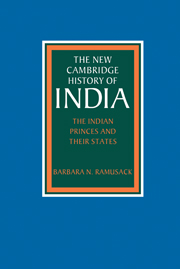Book contents
- Frontmatter
- 1 Introduction: Indian princes and British imperialism
- 2 Princely states prior to 1800
- 3 The British construction of indirect rule
- 4 The theory and experience of indirect rule in colonial India
- 5 Princes as men, women, rulers, patrons, and Oriental stereotypes
- 6 Princely states: administrative and economic structures
- 7 Princely states: society and politics
- 8 Federation or integration?
- Bibliographical Essay
- Glossary
- Index
- THE CAMBRIDGE HISTORY OF INDIA
- References
3 - The British construction of indirect rule
Published online by Cambridge University Press: 28 March 2008
- Frontmatter
- 1 Introduction: Indian princes and British imperialism
- 2 Princely states prior to 1800
- 3 The British construction of indirect rule
- 4 The theory and experience of indirect rule in colonial India
- 5 Princes as men, women, rulers, patrons, and Oriental stereotypes
- 6 Princely states: administrative and economic structures
- 7 Princely states: society and politics
- 8 Federation or integration?
- Bibliographical Essay
- Glossary
- Index
- THE CAMBRIDGE HISTORY OF INDIA
- References
Summary
Many empires, from the Roman to the Soviet Union, have employed indirect rule in an effort to extend their influence over disparate peoples and regions with a minimum of expenditure in material and human resources. This chapter delineates how the British devised and then sustained a system of indirect rule that reputedly provided a model that was adapted to many other imperial situations. In his comprehensive study of the British residency system, Michael Fisher has defined indirect rule in India as ‘the exercise of determinative and exclusive political control by one corporate body over a nominally sovereign state, a control recognised by both sides’. The four key elements are that:
both sides must recognise the control as effective;
only one entity can exercise control;
all other rivals must be excluded; and
the dominant power must recognise some degree of sovereignty in the local state.
Debate continues over the degree of the sovereignty or autonomy of the Indian princes before and after they concluded treaties with the British. Since its publication in 1943, Edward Thompson's classic work, The Making of the Indian Princes, about British relations with Mysore and the Marathas from the 1790s to the 1820s has been the bedrock of arguments that without the British the princely states would not exist. But this thesis has outlived its usefulness.
In most cases the British did not create the Indian princes as political leaders. Although many were coerced into subordination, princes usually sought political and material benefits from their agreements with the British.
- Type
- Chapter
- Information
- The Indian Princes and their States , pp. 48 - 87Publisher: Cambridge University PressPrint publication year: 2003



